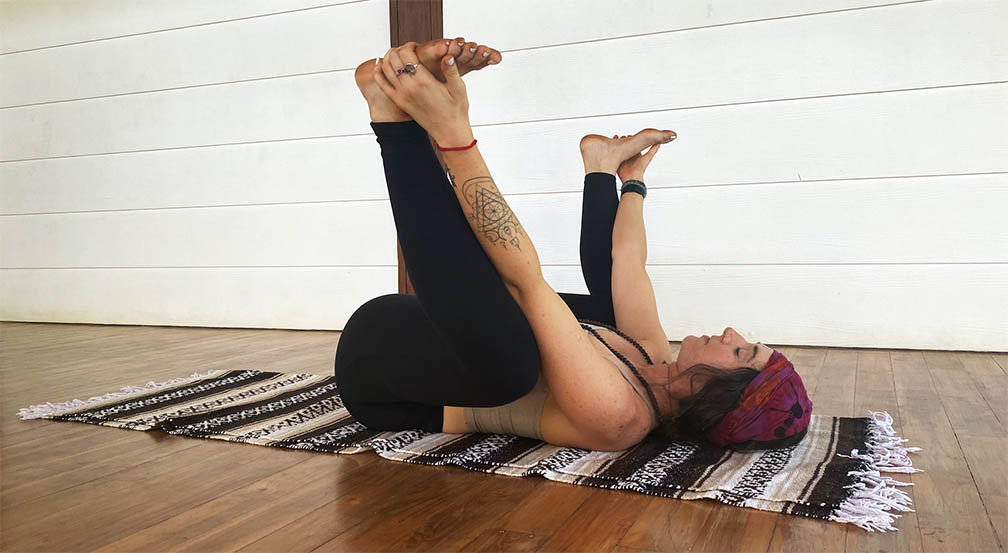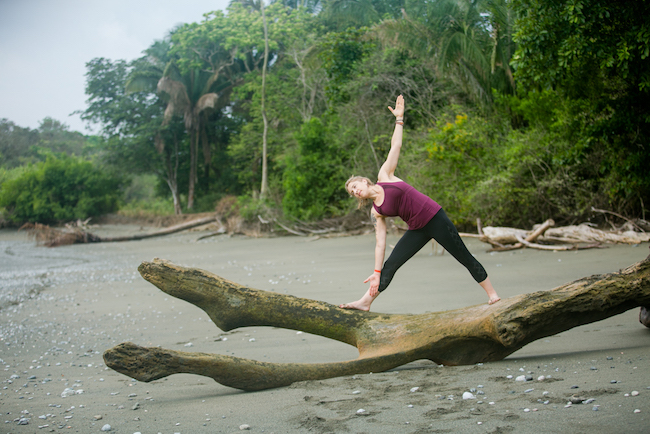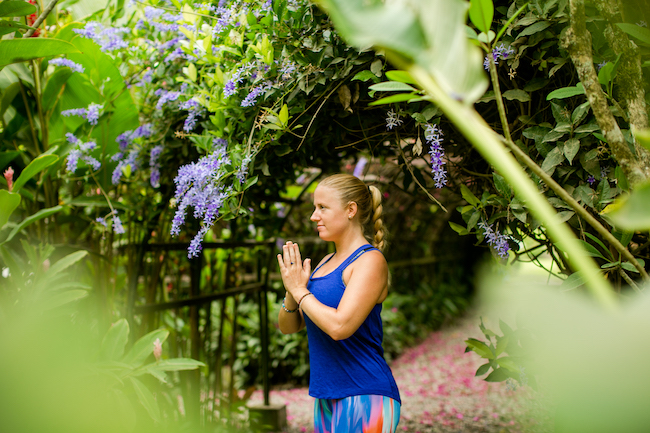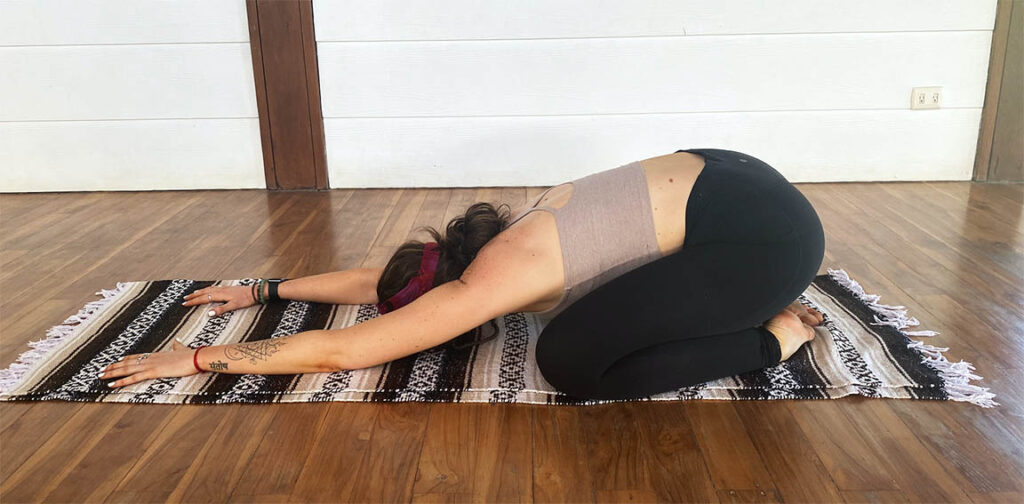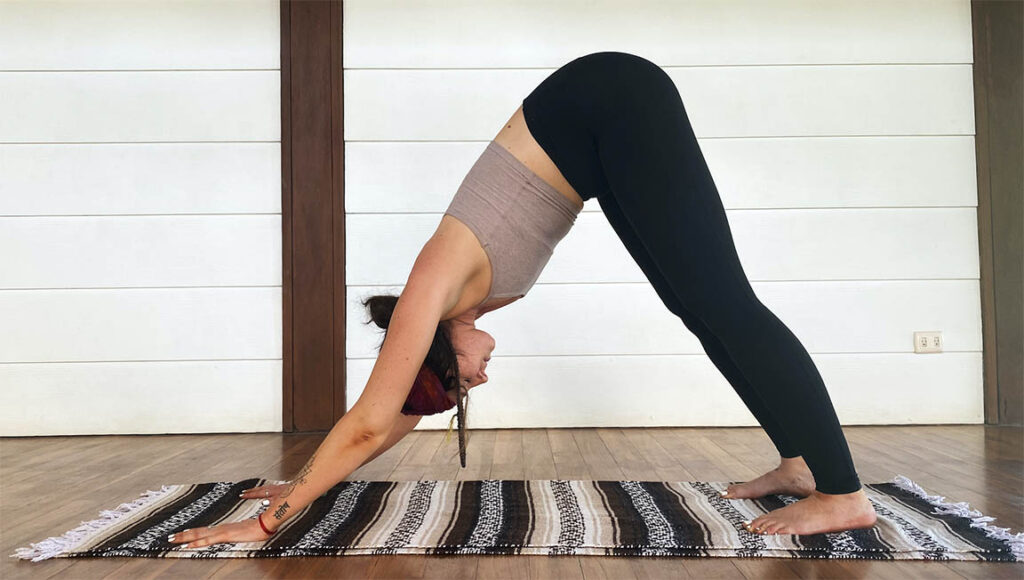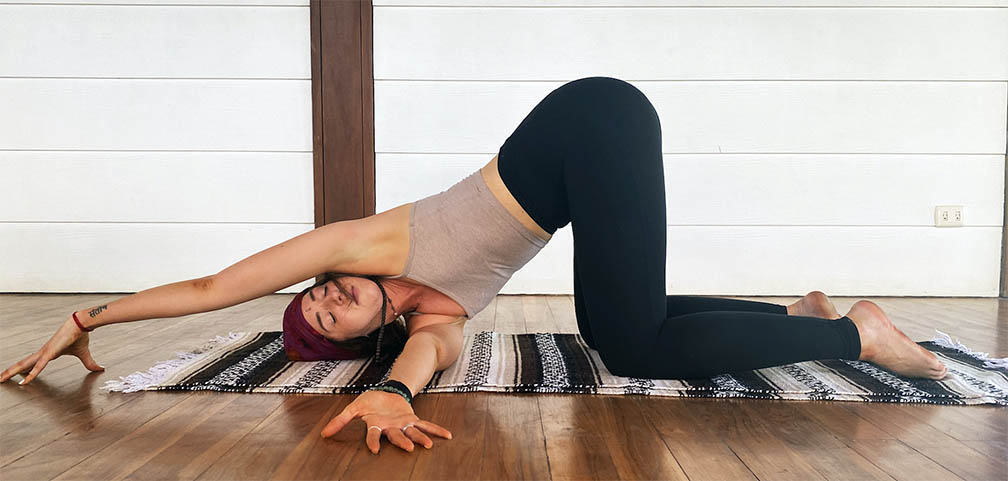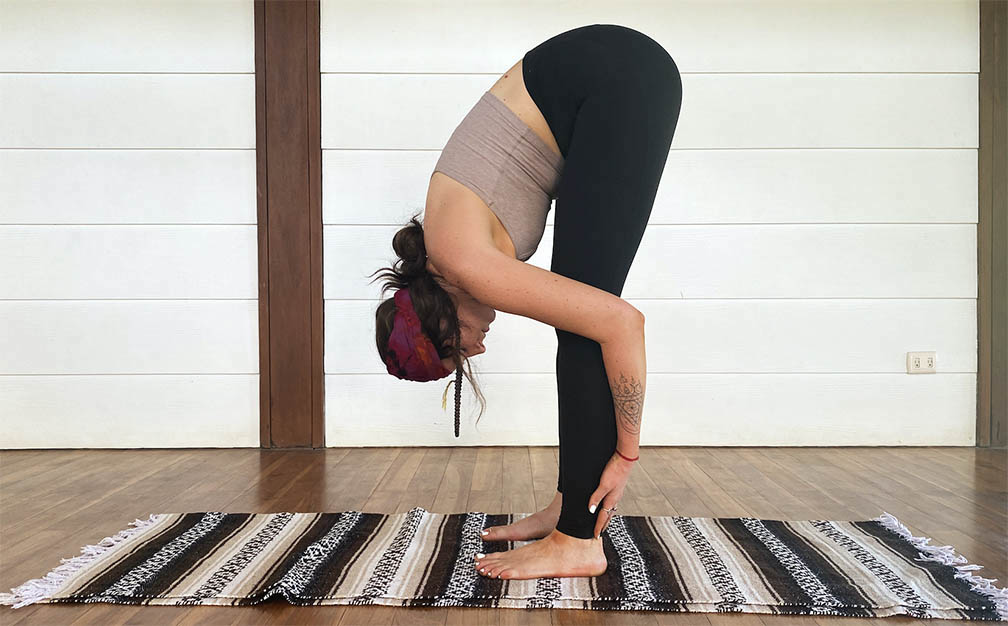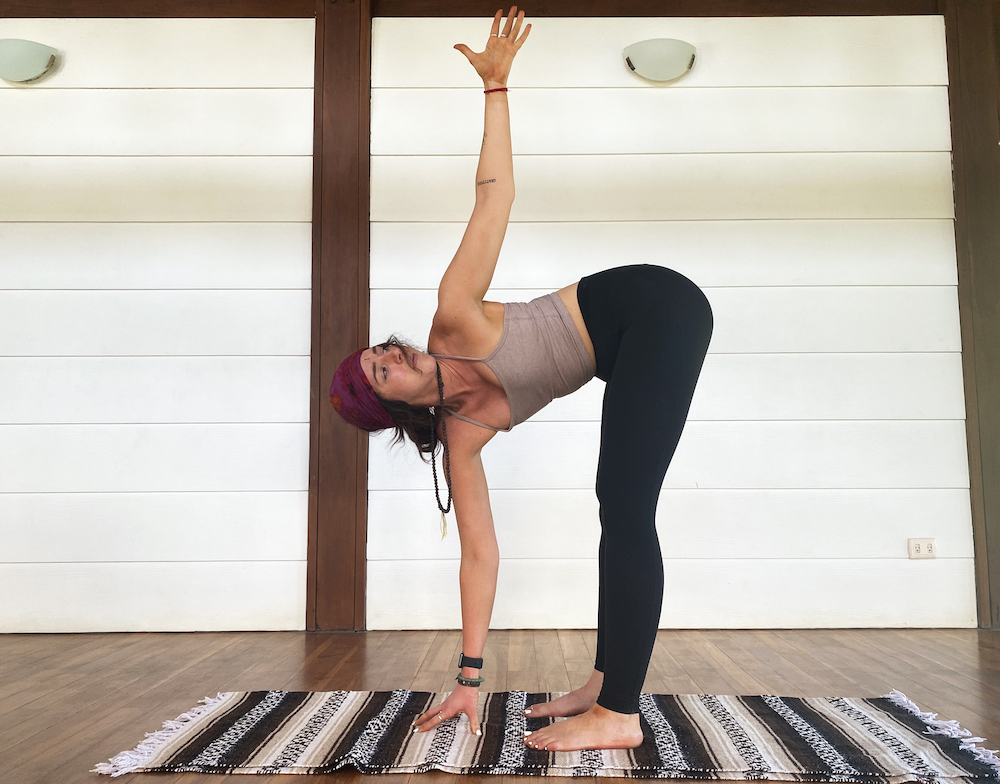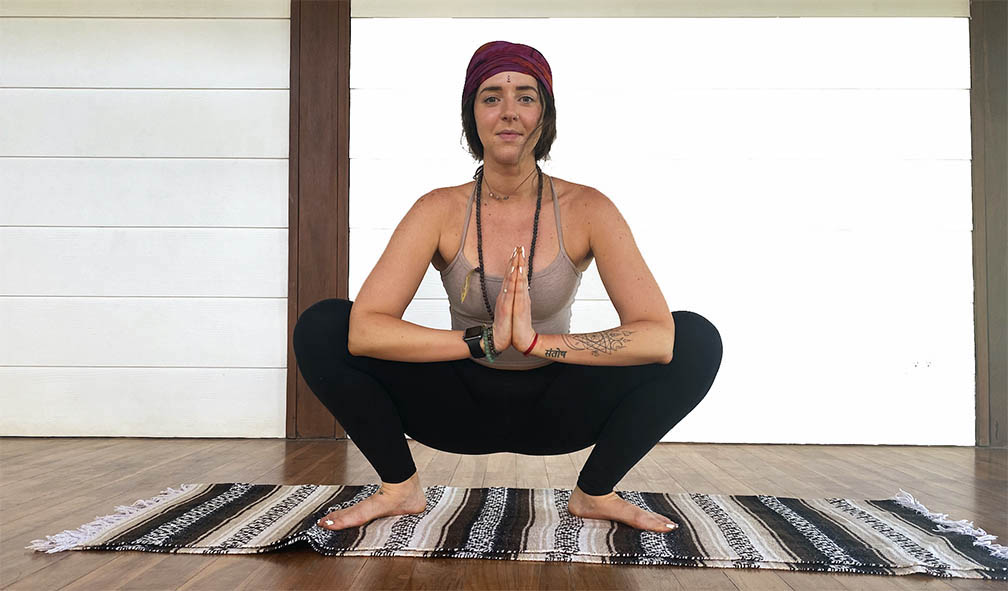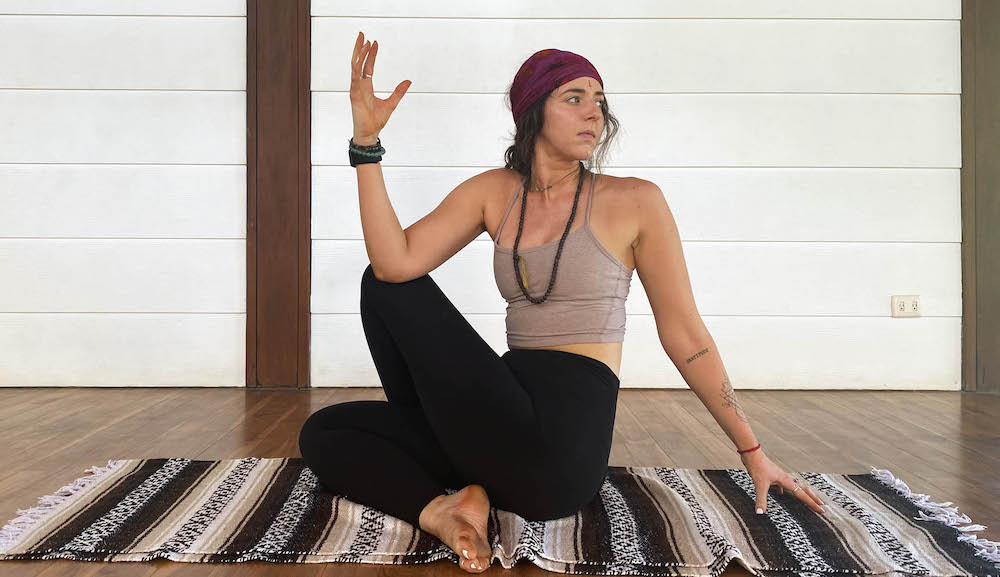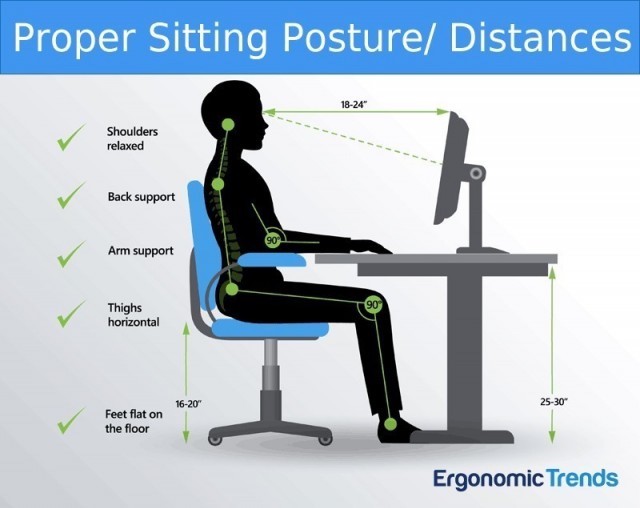Chances are, if you’re reading this, you are probably sitting. Or at least spent a large majority of the day sitting…Sitting while on your commute to the office, sitting at your desk and then sitting while watching television. If this sounds like you then perhaps you could benefit from some restorative yoga for sitting.
Our bodies are designed to move. And although we may make the effort to get up and stretch every hour, go for daily walks or even get our fitness on, we still sit a lot. Many of us can even feel it at the end of the day. Sore glutes, tight hips, achy back…This can be taxing on the body. But the hard part is, sometimes we need to sit! We all know it’s not great to stand while eating. And when working for six or more hours a day, standing is not always efficient. So what do you do when you sit a lot but don’t want to experience the negative effects prolonged sitting can have on the body? The answer: yoga.
Why Yoga is Great For People Who Sit A Lot
There are many amazing postures and yoga practices you can try to help relieve some of the pain you may feel after sitting all day. Yoga can also do wonders on the mind by improving your overall well-being and releasing tension from the body. Learning to accept yourself and practice self love are also great benefits of a regular yoga practice. So what are you waiting for?
If you are interested in deepening your yoga practice, consider signing up for one of Blue Osa’s many yoga teacher training courses. This will allow you to explore the history of yoga while also learning more about the many benefits yoga has on the body. Yoga teacher training can be a life changing experience. Located in Costa Rica, Blue Osa is also situated in one of the most biologically diverse places on the planet. Full of wildlife, the sounds of the ocean and farm to table meals, Blue Osa is the perfect place to launch your yoga journey.
What Happens When You Sit A Lot
Sitting all day can do a number of things to the body. We have all been told that living a sedentary lifestyle can be dangerous for your health. Research has linked a number of health concerns with sitting for prolonged periods of time. For example, high blood pressure, obesity and increased cholesterol levels. One study*, published by The American Journal of Preventive Medicine, suggests that sedentary behavior is negatively associated with health.
One possible explanation as to why prolonged sitting is bad for your health is a result of large muscles being relaxed for extended periods of time. As the largest muscle in the body, the gluteus maximus is relaxed when you are in a seated position. During this time, small amounts of glucose are taken up by the blood. This can lead to Type 2 Diabetes. In contrast, when standing or moving, more glucose is taken up by the blood which decreases your chances of developing certain health problems.
Prolonged sitting can also add stress to certain structures in the body. For example, the spine, shoulders and hips. And although there are postures to relieve pain in areas like the upper back, sitting can still worsen pain throughout the body. Stress in certain areas of the body can also be exaggerated with improper posture. The longer we sit, the more likely it is that we will slouch or move into unsupported positions. Even with the most ergonomically designed chair, sitting can cause issues. But fear not, yoga can help!
Why Yoga Is Great For Desk Jobs
If you have a desk job, then yoga should definitely be a part of your daily routine. After sitting all day, yoga is an amazing way to stretch out the body and engage parts of you that have been sedentary and stagnant. We all know that work is important but it’s also important to keep your mind and body healthy. There are many different types of yoga, but some are more active than others. If you are looking for a more active style of yoga, try hatha yoga or a vinyasa flow class. Alternatively, if you are interested in slower-paced yoga, try a restorative class or yin yoga. Blue Osa offers a wide variety of yoga classes to choose from. You can even check out some applied yoga anatomy and muscle activation classes!
There are so many benefits of yoga for those who work office and desk jobs. Even for individuals who have a relatively sedentary lifestyle. Below are just a few reasons why you should do yoga if you work a desk job:
- Reduced back pain
- Less stress
- Prevent health problems
- Improve digestion
- Regulate hormones
If you are looking for a great after work yoga routine, check out the poses below to help you counteract the discomfort you may feel after sitting all day.
Best Yoga Poses To Combat the Effects of Sitting
Child’s Pose (Balasana):
As a beginner’s posture, child’s pose is a grounding asana that is suitable for all experience levels. Child’s pose is often used as a resting posture in many yoga sequences. This is because of its grounding and relaxing effects. Calming and soothing the mind and body, child’s pose is a great posture to help relax the low back, neck and spine.
- Begin in a tabletop position (all fours)
- Spread your knees as wide as feels comfortable and bring the big toes to touch
- While sitting up straight, lengthen the spine
- On an exhale, bend forward so that your chest drops between the thighs. Allow your forehead to rest on the mat, block or blanket
- Extend your arms out in front of you with your palms facing the floor. Alternatively, you can also draw your arms back down beside the body if this feels more comfortable
Child’s pose can be held for as long as you need. Focus on relaxing and softening the lower body. Release all tension in the arms and lower back.
Downward Dog (Adho mukha svanasana):
Downward facing dog may be one of the most widely recognized yoga postures. As an asana that strengthens the arms, low back and hamstrings, this posture is great for anyone who suffers from lower back pain.
- Begin this posture in a tabletop position. Hands should be shoulder-width apart with fingers spread out side
- Press your hands into the mat as you tuck your toes and send your hips back. (replicating an upside down “V” shape with your body) Feet are hip-width distance apart
- Draw your belly button towards the spine and press your feet down
- Keep your neck relaxed as you draw your gaze towards the ankles
This posture can help remove fatigue and also tone abdominal muscles.
Thread the Needle (Parsva balasana):
As a gentle twist pose, thread the needle activates, stretches and relieves a lot of built up tensions caused by sitting from the body. This posture is great for individuals who hold a lot of tension in the upper back, specifically between the shoulder blades. Thread the needle allows your chest to open while also relieving pressure in the shoulders.
- Begin this posture in a tabletop position. Wrists are stacked underneath the shoulders and knees are hip-width apart, directly below the hips
- As you exhale, thread your right arm underneath your left arm while your palm remains face up
- Allow your right shoulder to come down to the mat as you rest your right cheek on the ground. Gaze should be to the left
- Continue to use your left hand for support, avoiding pressing any weight into your head. Ensure that you are not straining your shoulder or neck
- Relax and soften your low back, allowing tension in the arms, neck and shoulder to melt away
Try to hold this posture for about a minute then repeat on the other side. Then slowly release using your left hand for support. As a calming position, remember to make any adjustments where you feel necessary.
Forward Fold (Uttanasana):
When we sit at a desk or in a chair for prolonged periods of time, we can often lose strength in the spine. This is why postures like forward fold are beneficial to incorporate into your yoga practice for people who sit a lot. As a simple yet effective posture, standing forward fold is a great asana to facilitate a deep and satisfying stretch in the back. Targeting the whole body, forward folds help calm the mind while also stretching the hamstrings, calves and hips.
- Begin this posture in mountain pose (tadasana). Feet are hip-width apart planted firmly into the mat
- Create a slight bend in the knees and lengthen the spine
- On an exhale, hinge at the hips and fold your torso over legs
- Extend the spine further as you inhale
- Ensuring that you are not hyperextending the legs, reach your hands to your mat or toes
- The crown of your head is facing the ground and shoulders are drawn back to the hips
Remember that this posture is not about being able to touch your toes. It’s about releasing tension in the back and countering the negative effects caused by prolonged sitting. If you feel comfortable you can also grab either elbow with your opposite hand for ragdoll pose.
Revolved Standing Forward Fold (Parivrtta uttanasana):
As a forward fold variation, revolved standing forward fold is another great posture to open the muscles of the back and the legs. Similar to a forward fold, this posture stretches the entire back body as well as the sides of the waist. Revolved standing forward fold can also improve digestion and help with fatigue and anxiety.
- Following the steps above, move into a forward fold
- With the crown of the head facing the mat, keep your right hand down (if you cannot reach the mat you can also use a yoga block for assistance)
- Reach your left hand overhead and twist to the left
- You can either keep your gaze down on the mat or look up towards your left fingertips
- Hold this posture for 30 seconds to a minute before switching to the other side
Twisting postures are great for the spine. This is because they are a great way to stretch the lower back and improve function in the abdominal organs.
Garland Pose (Malasana):
Also known as the yogi squat, garland pose is a great posture that opens the hips and counteracts the tightness that can develop from prolonged sitting. In many places around the world, this position is used as a resting posture and is also commonly practiced naturally by children. However, most adults in the western world have gotten out of this habit and can typically find this asana uncomfortable. If this sounds like you, props such as a yoga block or blanket can be used beneath the feet or hips to assist with this posture.
- Begin this posture in mountain pose. Feet are hip-width apart and firmly grounded into the mat
- Slowly bend your knees and lower into a squat
- With a slight tilt forward, move your torso between your thighs and bring your palms together into Anjali mudra
- Keep your spine straight and relax your shoulders
- Lift the chest, keeping your neck long while you keep your gaze forward
- Breathe deep here for about 30 seconds to a minute
- To exit this posture, you can either slowly stand or bring your hands down to the mat and move into a forward fold
- Come back into mountain pose and take a moment to feel new energy moving through the body
Garland pose not only opens the hips but can also improve your range of motion. This posture is also a great transition into crow pose (bakasana).
Happy Baby (Ananda balasana):
Happy baby is an amazing posture to bring greater awareness to your hips. It also works to stretch the inner groin muscle as well as the spine. Gentle, calming and restorative, this posture is often performed at the end of a routine to help calm down the mind and body. Great for beginners, happy baby is an easy posture with many different effects.
- Begin this posture by lying on your back
- Bend your knees into your belly and reach your hands to grab the outsides of your feet
- Shins should be perpendicular to the floor
- With your feet flexed, press into your hands while gently pulling down for some slight resistance
If you are someone who needs help relieving some stress and fatigue, then happy baby is the posture for you.
Seated Supine Twist (Jathara parivartanasana):
Another great twisting posture, the supine twist is a refreshing asana to help wring out the core and leave you feeling great. Twists not only help you stretch out the spine but they are also amazing ways to improve digestion and shift your energy. This posture will leave you feeling amazing from the inside out!
- Begin this posture seated on your mat. Legs are extended out in front of you.
- Bend your right knee and cross it over the left leg. Your right foot should be on the outside of your left knee. Foot is flat on the ground
- Bend your left knee and bring your left ankle to your right glute. Ensure that your hips remain square
- Reach your right arm up and behind you, gently placing your fingertips on the floor
- Slowly twist your body to the right
- Raise your left arm above you and hook it around your bent right knee
- Through deep inhales and exhales, twist further to the right
- Hold this posture for about 30 seconds before gently releasing and repeating this posture on the other side
The seated supine twist is a great way to detoxify the body as well as calm the nervous system. You can also replicate this posture when sitting at your desk! Simply turn to the right and place your right hand on the back of the chair. Place your left hand on your desk and twist up through the spine. Although you are not sitting on the floor, this movement will still leave you feeling great.
How To Properly Sit in a Chair
So, now that you have learned about some different poses that can help you recover from sitting all day. Let’s discuss some strategies that can help you while sitting. The first step towards great sitting posture is to ensure that you have a comfortable chair. Ideally a chair that has a soft surface to prevent discomfort. But not too soft – think of a padded desk chair. It is also important to have a chair with support for your back.
Stools can be great for short-term work, but having back support is essential. Then, sit up with your spine straight and shoulders back. Try to sit at the end of your chair to avoid slouching and position the back of your chair so that you are supported. Place your feet flat on the floor. Crossing your legs can lead to posture-related problems like slouching. Finally, adjust your screen so that it is at eye level. This will prevent your head from tilting and an uncomfortable angle.
It’s also important to not only give yourself mental breaks, but breaks that will get you a little more active. If you can, stand up and stretch. You can even go for a quick walk or up and down the stairs a couple of times. A great tip is to also eat lunch or a snack somewhere other than your desk. There are lots of delicious meal prep recipes out there that you can pack with you. Take a look at this Indian cauliflower potato delight. This recipe is great to make the night before work and pack in a thermos for a great on-the-go lunch.
Additional Ways to Improve Your Posture
Sometimes, all we need is a bit of help to adjust our posture. If you are wanting some further tips to help you when you sit a lot, check out this quick hack to correct your posture.
Are you still thinking about ways to incorporate more movement and activity in your day? Or perhaps you are in need of a digital detox? If so, check out some of the upcoming retreats that Blue Osa has to offer. Not only will you be able to focus on your physical health. But you can also take this time to relax and work on your mental health as well. There is even a luxury spa with a number of great services at your fingertips. So what are you waiting for? Get up out of that chair, grab your mat and start discovering the many benefits that yoga has to offer.


